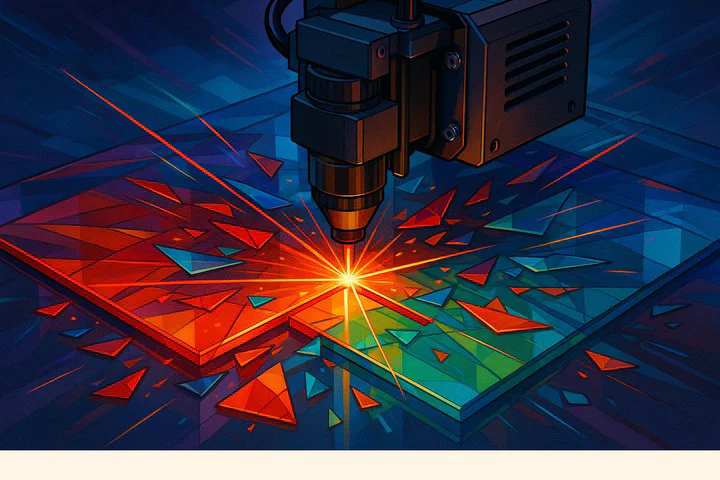Using Acrylic with a Diode Laser

Introduction to Using Acrylic with Diode Lasers
Have you ever seen a laser cut a perfect shape into plastic? That bright beam comes from a diode laser. A diode laser is a small machine that uses light to cut or engrave many materials. More and more makers are using acrylic with a diode laser to create keychains, ornaments, and cosplay parts at home.
Acrylic is a type of plastic that’s lighter and safer than glass. It comes in many colors and even sparkly styles. When you work with acrylic with a diode laser, you can slice crisp lines and smooth curves without touching a saw. That means less mess and more time to create.
Why pick a diode laser over other kinds? First, diode lasers are small enough to fit on a table and cost less than big CO₂ or fiber lasers. They also use less power, which is great if you craft in a bedroom or small studio. Still, using acrylic with a diode laser has a few hurdles. Thick sheets can be hard to cut, shiny surfaces can reflect the beam, and melting plastic makes smoky fumes.
Don’t worry—this guide will show you each step, share tricks for clean cuts, and keep your workspace safe.
Step-by-Step Guide to Cutting Acrylic with a Desktop Diode Laser
Before you start using acrylic with a diode laser, gather everything you need:
- Desktop diode laser machine
- 3 mm–5 mm acrylic sheet (lighter colors cut easier)
- Honeycomb or metal grid bed
- Painter’s tape or magnets to hold the sheet
- Laptop with design software (Inkscape or LightBurn)
- Safety glasses made for your laser’s color
Set up your laser in a place with good airflow. Put the honeycomb bed flat, then tape or pin the acrylic so it can’t move. Focus the laser by lowering the head until the built-in gauge—or a scrap of wood—just fits under the nozzle. A sharp focus means fewer passes and less melted plastic when you work with acrylic with a diode laser.
Load your SVG or DXF file in the software, choose the “cut” layer, and test a small square near a corner. Start with 100 % power and about 200 mm/min speed for 3 mm acrylic. Check if the back edge looks clean. If the cut isn’t smooth, slow the speed a little. Once the test works, you’re ready for the real design. You’ll feel a thrill the moment you finish cutting one out of acrylic on a desktop laser and lift the shiny piece free.
Last, fight the fumes. Acrylic turns into white mist and smells like syrup when it melts. Without venting, your room can get full of burning acrylic smoke, clouding the lens and your lungs. Aim a small exhaust fan out a window or attach dryer hose to the laser’s back port. Wipe the lens after every long cut so your projects stay crisp.
Comparing Diode Lasers with Other Laser Types
When you shop for a laser, you will see three main kinds:
- Diode lasers are small and affordable.
- CO₂ lasers are larger, water-cooled, and cut thick plastic fast.
- Fiber lasers are mostly for marking metal and cost the most.
If you plan to work with acrylic with a diode laser, the small size and price make it a smart starting point.
A diode laser can slice through 3 mm acrylic with a few slow passes. A CO₂ laser can blast through 6 mm or even 10 mm acrylic in one pass, but it needs more space and stronger venting. Fiber lasers often ignore clear plastic; their beam slips right through unless the acrylic is painted. You may have watched a tutorial where a guy on youtube was using a fiber laser and the cut looked lightning fast. Remember, that machine likely cost more than a used car.
Choose the tool that fits your goals and budget. For hobby crafts, cosplay badges, and small art pieces, a diode laser gives plenty of creative power without draining your wallet.
Tips for Safe and Clean Laser Cutting
Safety is key when using acrylic with a diode laser. The hot beam melts plastic, and that makes smoke. Always place the machine near a window or vent. Clip a dryer hose to the exhaust port and aim it outside. A small desk fan helps push fumes toward the hose. Good airflow keeps your room from getting full of burning acrylic smoke and stops fog from coating the lens.
Add an air-assist pump if your laser supports one. This little pump blows air right where the beam meets the acrylic. It clears away melted bits, cools the cut, and reduces flare-ups. Even if you only work with acrylic with a diode laser a few times a month, air assist makes each pass cleaner and faster.
Wear the right gear every time. Safety glasses that match your laser’s color keep your eyes safe. Keep a small spray bottle of water and a Class C fire extinguisher within reach. Never leave the room while the laser runs.
Finish strong by cleaning up. Wait for the sheet to cool, then wipe the honeycomb bed with a damp cloth. A cotton swab and a drop of rubbing alcohol will polish the lens after each long job. Store scrap pieces flat so they don’t warp. These simple habits let you enjoy laser crafting again and again.